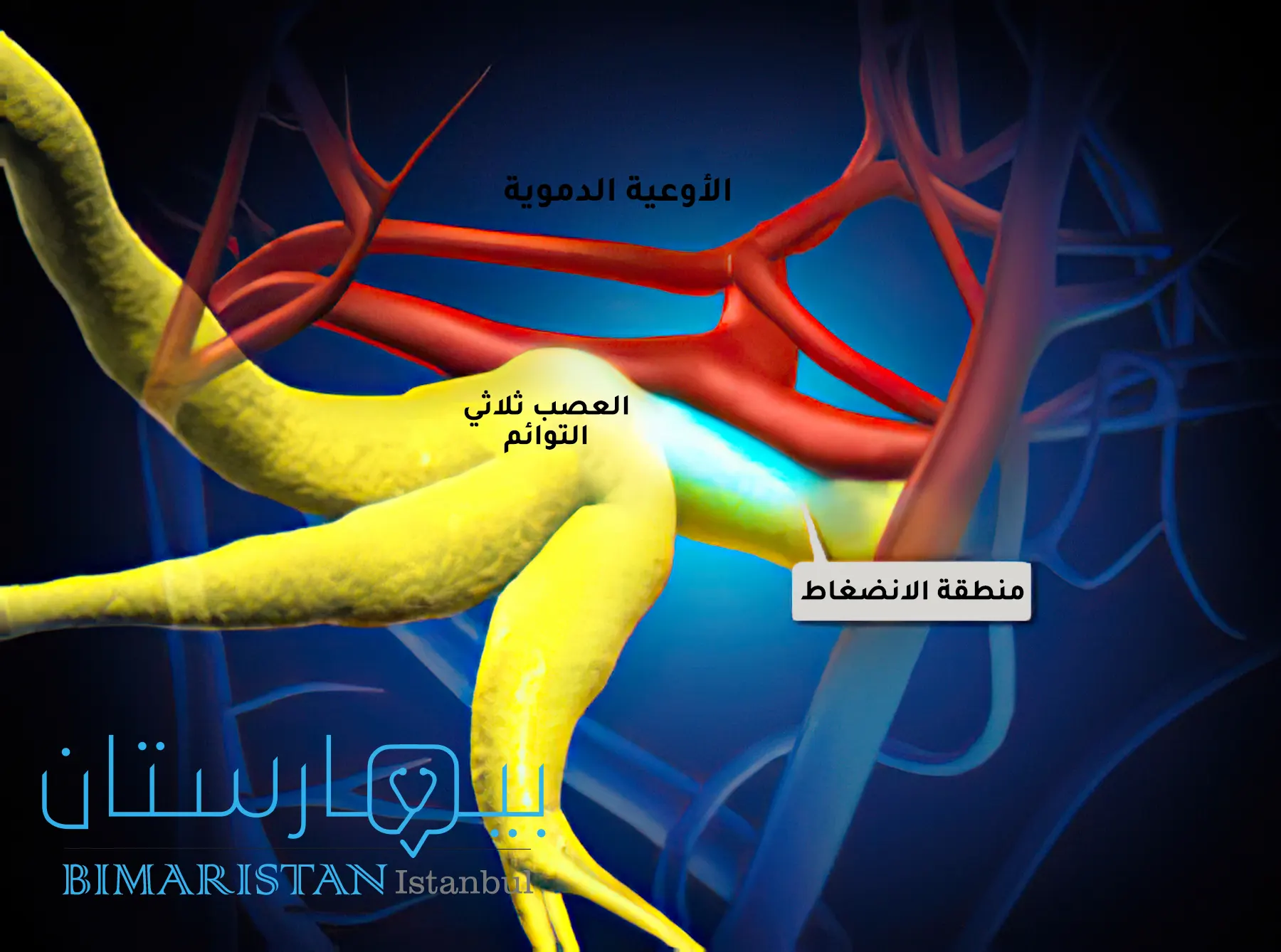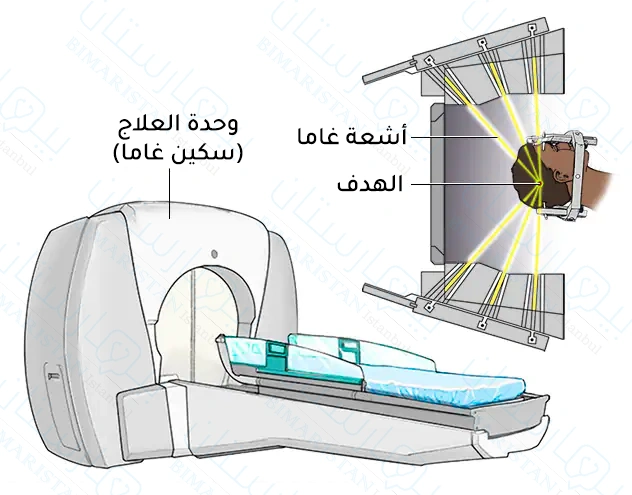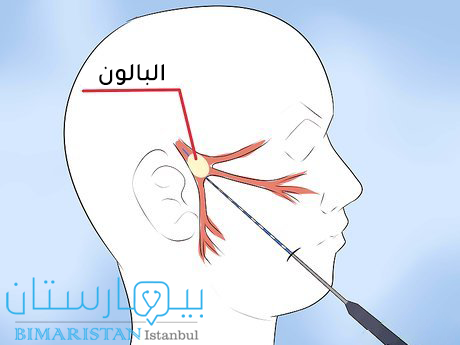التهاب العصب الخامس هو حالة ألمية تؤثر على أعصاب معينة في الوجه تأتي نوبة الألم على شكل هجمات قصيرة غير متوقعة يمكن أن تستمر من بضع ثوانٍ إلى حوالي دقيقتين، تتوقف الهجمات فجأة كما بدأت.
ما هو التهاب العصب الخامس؟
يأتي ألم التهاب العصب الخامس trigeminal neuralgia على شكل صدمة كهربائية قد تكون شديدة أحياناً.
من الممكن للألم أن يتحسن أو يختفي تماماً لعدة أشهر أو سنوات (فترة الهدأة) ، على الرغم من أن هذه الفترات تميل إلى أن تصبح أقصر مع مرور الوقت.
إن التعايش مع ألم العصب الخامس صعب للغاية، ويؤثر التهاب العصب الخامس بشكل كبير على نوعية حياة الشخص وغالباً ما تؤدي إلى مشاكل أخرى مثل فقدان الوزن والعزلة والاكتئاب.
لمعرفة المزيد عن مرض التهاب العصب الخامس، من المهم معرفة توضعه في الوجه.
أعراض التهاب العصب الخامس
قد يظن الأشخاص المصابون بالالتهاب أن لديهم آفة جذرية في أحد الأسنان.
بالنسبة للأشخاص الذين يعانون من التهاب العصب ثلاثي التوائم غير النمطي، atypical trigeminal neuralgia، والمعروف أيضاً بالنمط 2 للمرض يكون الألم أقل شدةً ولكن مستمر.
يعتبر الأطباء أن الإصابة بنوبات من الألم المفاجئ والشديد هو من اعراض التهاب العصب الخامس الكلاسيكي، أما إذا كانت طبيعة الألم هي شعور حارق فإنه غالباً النمط الثاني.
تشمل الأعراض الشائعة لالتهاب العصب الخامس ما يلي:
- يأتي على شكل نوبات تستمر من بضع ثوانٍ إلى عدة دقائق.
- تتكرر النوبات عدة مرات في اليوم أو الأسبوع، تليها فترات لا يحدث فيها أي ألم، تعرف هذه الفترات الخالية من الألم باسم فترة خمود الأعراض (هدأة الأعراض)
- الشعور بالنخز لفترة وجيزة.
- الألم المثار بأمور مثل تنظيف الأسنان الحلاقة غسل الوجه أو وضع المكياج، حتى النسيم الخفيف على الوجه قد يسبب الألم.
- يؤثر الألم عادةً على جانب واحد من الوجه فقط.
- خلال النوبة، غالباً ما تزداد شدة الألم بمرور الوقت.
- يحدث الم في الخد والفك والأسنان واللثة والشفة بشكل رئيسي، في حين أن العينان والجبهة تتأثران بشكل أقل.
- بعد انتهاء النوبة قد يرتعش الوجه لاإرادياً.
- يعاني بعض الأشخاص المصابون بشلل العصب الخامس من القلق، وذلك لأن موعد نوبة الألم الشديد التالية غير معروف.
محفزات التهاب العصب الخامس
- لمس الوجه بلطف
- الحلاقة
- غسل الوجه
- تنظيف الأسنان بالفرشاة
- وضع المكياج
- الأكل والشرب، خاصةً المأكولات والمشروبات الباردة والساخنة
- التكلم
- الابتسام
- هبوب الرياح أو النسيم على الوجه
ومع ذلك في بعض الأحيان تحدث نوبة الألم دون وجود محفز.
أسباب التهاب العصب الخامس
قد يحدث التهاب العصب الخامس نتيجة لأحد هذه الأسباب:
-
ضغط من أحد الأوعية الدموية المجاورة، مما يؤدي إلى إتلاف الطبقة الواقية المحيطة بالعصب والتي تسمى غمد النخاعين.

- تؤدي بعض الأمراض مثل التصلب المتعدد إلى ضرر في غمد النخاعين.
- يمكن أن يصاب العصب أيضاً نتيجة لجراحة أو حادث أو سكتة دماغية.
- بعض الأشخاص أكثر عرضةً للإصابة بالتهاب العصب الخامس من غيرهم:
- النساء أكثر عرضةً للإصابة بالتهاب العصب الخامس من الرجال.
- يظهر التهاب العصب الخامس غالباً عند الأشخاص الذين تزيد أعمارهم عن 50 عاماً.
- الأشخاص في عائلات تضم مصابين.
متى نطلب الاستشارة الطبية؟
- يجب مراجعة طبيب الأسنان عند الإحساس بألم متكرر أو مستمر في الوجه، خاصة إذا كانت المسكنات الاعتيادية كالباراسيتامول والإيبوبروفين لا تخفف من الألم.
- عندما ينفي طبيب الأسنان أي مشكلة تتعلق بالأسنان يجب مراجعة الطبيب العام الذي سيحاول تحديد المشكلة عن طريق السؤال عن الأعراض واستبعاد الحالات الأخرى التي قد تكون سبب الألم.
ومع ذلك قد يكون تشخيص التهاب العصب الخامس صعباً ويمكن أن يستغرق بضع سنوات حتى يتم تأكيد التشخيص.
تشخيص التهاب العصب الخامس
- إذا كان الألم في الوجه يحدث بشكل متكرر ولا يستجيب للمسكنات فيجب عندها مراجعة الطبيب.
- عادةً ما يسأل الطبيب عن كيفية ظهور الألم لأول مرة وعدد مرات حدوثه وما الذي يحفز ظهوره.
- قد يتم إجراء فحص عصبي حيث يلمس الطبيب أجزاء مختلفة من الوجه ويراقب ردود الأفعال وذلك لمعرفة ما إذا كان العصب مضغوطاً.
- يمكن أن تظهر اختبارات التصوير مثل التصوير بالرنين المغناطيسي MRI ما إذا كان الورم أو التصلب المتعدد هو سبب المشكلة.
علاج التهاب العصب الخامس في تركيا
تشمل العلاجات المتوفرة لدى مركز بيمارستان في تركيا الأدوية وأحدث الطرق الجراحية.
الأدوية
لا تعمل مسكنات الألم الاعتيادية بشكل جيد مع المصابين بالتهاب العصب الخامس، لذلك قد يصف الطبيب أنواعاً مختلفة من الأدوية كالتالي:
- لمنع حدوث ألم شديد بسبب تهيج هذا العصب، يمكن تناول الأدوية المضادة للاختلاج مثل كاربامازيبين carbamazepine والذي يُستخدم غالباً في علاج الصرع، حيث يخفف الكاربامازيبين من آلام الأعصاب عن طريق إبطاء النبضات الكهربائية في الأعصاب وتقليل قدرتها على نقل سيالات الألم، وإذا بدأت فترة هدوء الأعراض، حيث يختفي الألم، فيجب دائماً إيقاف الكاربامازبين ببطء، على مدار أيام أو أسابيع، ما لم ينصح الطبيب بخلاف ذلك.
- يمكن تناول المرخيات العضلية أيضاً /بمفردها أو مع مضادات الاختلاج/.
- قد يقترح الطبيب مضادات الاكتئاب ثلاثية الحلقات للتحكم في الأعراض.
- تشير بعض الأبحاث إلى أن حقن البوتوكس قد تكون مفيدة عندما لا تخفف الأدوية الأخرى من آلام العصب الخامس، مع ذلك هناك حاجة إلى المزيد من البحث قبل أن يصف الأطباء هذا على نطاق واسع.
الجراحة
تنخفض فعالية الأدوية بمرور الوقت وعند حصول ذلك يكون لدينا عدة خيارات جراحية، بعضها تتم في العيادات أي أن المصاب ليس مضطراً للدخول إلى المشفى، يحدد الطبيب الجراحة المناسبة للمريض بناءً على صحته العامة والأعصاب المعنية وتفضيلات المريض الشخصية.
الجراحة الإشعاعية التجسيمية للمخ (سكين غاما)، في هذه الجراحة يوجه الجراح جرعة مركزة من الإشعاع إلى جذر العصب ثلاثي التوائم.
تستخدم هذه الجراحة الإشعاع لتدمير العصب ثلاثي التوائم وتقلل الألم أو تزيله ويحدث التعافي تدريجياً وقد يستغرق مدة تصل إلى شهر.

ضغط البالون، حيث يقوم الأطباء بإدخال بالون فارغ في فراغ بين العصب ثلاثي التوائم وقاعدة الجمجمة وعندما يتم نفخ البالون، يتم ضغط العصب على العظام الصلبة، مما يؤدي إلى إتلاف عزل العصب، وحجب إشارات الألم.

حقنة الجليسرول، والتي يتم حقنها في السائل الشوكي المحيط بالعصب ثلاثي التوائم، وهذا ما يضر بالعزل حول العصب مما يخفف الألم.
الاستئصال بالترددات الراديوية، حيث يقوم الطبيب والمريض جنباً إلى جنب في تحديد المنطقة التي يصدر عنها الألم بدقة، ثم يقوم الطبيب بإرسال تيار كهربائي إلى تلك البقعة لتخفيف الألم.
تخفيف ضغط الأوعية الدموية الدقيقة MVD، حيث يتم تحريك أو إخراج الأوعية الدموية التي تضغط على العصب، توفر هذه العملية تسكين الآلام بشكل فوري في 95٪ من المرضى، حوالي 20٪ من المرضى يعانون من تكرار الألم في غضون 10 سنوات، الفائدة الرئيسية منها هي أنها لا تتسبب في حدوث خدر للوجه وإذ حدث فإنه يكون بسيطاً، العيوب الرئيسية هي مخاطر التخدير بالإضافة إلى خطر إجراء عملية بالقرب من الدماغ.
قص الجذر الانتقائي الظهري، وهو قطع لا رجعة فيه لجذر العصب ثلاثي التوائم عند منطقة اتصاله بجذع الدماغ، يتم عمل فتحة صغيرة في مؤخرة الجمجمة ويستخدم مسبار التحفيز لتحديد الجذر الحركي للعصب، يجب الحفاظ على الجذر الحركي الذي يتحكم في عضلات المضغ، يتم قطع ألياف الجذر الحسية، التي تنقل إشارات الألم إلى الدماغ، يتسبب قطع العصب بخدر دائم في الوجه ويجب ألا يؤخذ هذا الخيار بعين الاعتبار إلا عند الألم المتكرر الذي لا يستجيب للعلاجات الأخرى.
استئصال العصب المحيطي، وهو نوع من الجراحة التي يمكن إجراؤها على فروع العصب من خلال شق صغير في الجلد، قد يكون قطع العصب فوق الحجاجي (فرع من قسم الأول v1) مناسباً إذا تم عزل الألم في المنطقة فوق الجبهة، ويمكن إجراء قطع العصب تحت الحجاجي (فرع من قسم V2) إذا كان الألم يقتصر على المنطقة الواقعة أسفل العين على طول العظم الوجهي، يؤدي قطع العصب إلى خدر كامل في المنطقة التي يعصبها.
الملخص
لا يوجد إجراء معين هو الأفضل لجميع المرضى إذ يختلف كل إجراء في فعاليته وفي آثاره الجانبية.
إن تخفيف ضغط الأوعية الدموية الدقيقة MVD والاستئصال بالترددات الراديوية لهما معدلات مماثلة لتسكين الآلام على المدى الطويل والتي تعد الأعلى من بين الخيارات المتاحة الأخرى.
في دراسة أجريت على ما يقرب من 100 مريض أو أكثر نُشرت في السنوات العشر الماضية كانت معدلات تخفيف الآلام 77٪ لجراحة تخفيف ضغط الأوعية الدموية الدقيقة MVD و75٪ للاستئصال بالترددات الراديوية.
يمكن أن يتكرر ألم العصب ثلاثي التوائم في أقسام العصب التي كانت خالية منه سابقاً، يمكن أن يحدث هذا بعد جميع العلاجات السابقة وقد يكون بمثابة تطور الاضطراب الأساسي وليس معاودة ظهوره.
العلاج الطبيعي لالتهاب العصب الخامس
هناك بعض الطرق البديلة التي قد تساعد في التحكم بأعراض التهاب العصب الوجهي والتي قد ترغب بسؤال الطبيب عنها:
- الوخز بالإبر Acupuncture (تقليد صيني يستخدم إبر رفيعة جدًا لموازنة تدفق الطاقة في الجسم)
- العلاج بالزيوت العطرية Aromatherapy (استخدام الزيوت النباتية مثل النعناع والخزامى وما إلى ذلك للمساعدة في الشفاء)
- اليوجا
- الارتجاع البيولوجي Biofeedback (كيفية التحكم بوظائف الجسم لتقليل الألم)
على الرغم من أن الألم يمكن أن يكون شديد جداً في التهاب العصب الخامس إلا أنها حالة لا تهدد الحياة.
